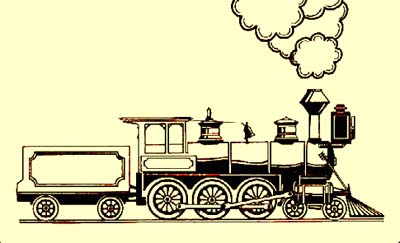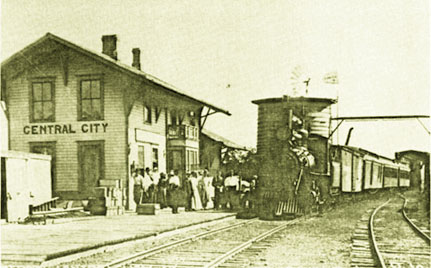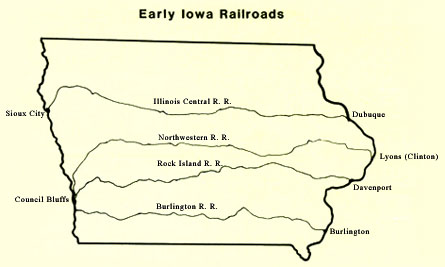Growth of the |
|
By 1850, no railroad tracks had yet been laid in Iowa. Iowa's population was mostly in the eastern part of the state. Iowan's had for years relied on horses, steamboats, stagecoaches, wagons, and foot power for travel. Newcomers to Iowa, such as the Dutch who traveled from Keokuk to Pella in 1847, used wagons drawn by oxen. In 1854 workers began cutting wood for railroad ties. They graded the roadbeds in anticipation of the coming of the railroad. Work was difficult because heavy rails had to be carefully gauged and spiked. In 1855 a locomotive named the Antoine LeClaire was brought across the Mississippi by ferryboat. This locomotive was named for a leading citizen of Davenport and Muscatine. Soon, the tracks reached to Iowa's capital, Iowa City. Much of this was completed by the Mississippi and Missouri Railroad Company. Soon other companies were formed and began laying track.
Along with private railroad companies, the government helped the railroads develop in Iowa. An act passed by Congress in 1856 helped railroad construction both before and after the Civil War. This act provided strips of land to be used for railroad construction. During the Civil War (1861-65), railroad construction nearly came to a halt. Iowa's attention was turned to the war rather than moving west. After the war, the Act of 1856 was helpful to continue construction of railroad lines in Iowa. The Act of 1856 enabled four railroad lines to be built across the state. The Burlington Railroad ran from Burlington to just south of Council Bluffs. The Rock Island ran from Davenport to Council Bluffs. The Northwestern ran from near Clinton to Council Bluffs. The Illinois Central ran form Dubuque to Sioux City. The Northwestern Railroad was the first to span the state. In 1867 the final tracks were laid connecting Council Bluffs to the Mississippi near Clinton.
Another act, the Pacific Railroad Enabling Act was signed by President Abraham Lincoln on July 1, 1862. This law was set up to authorize work on a railroad which would reach from the east coast to the west coast of the United States. Two railroad companies helped to complete the rail line. The Union Pacific Railroad moved east form Sacramento, California. Grenville Dodge, an Iowan was appointed by President Lincoln to be construction engineer. On May 10, 1869 the two railroad companies met at Promontory Point, Utah. A golden spike was used to signify completion of the railroad which linked the Atlantic and Pacific Oceans by rail. Between 1867 and 1895 Iowa's railroads continued to expand rapidly. By 1895 every county in Iowa was crossed by a railroad. Iowa's railroad building continued after 1895 as well. Between 1895 and 1904 the mileage of track in Iowa doubled. The railroads played an extremely important part in the development of Iowa. By completing tracks across the state, it made it possible within a few years to connect the eastern United States with the western states. Explorations in Iowa History Project |


